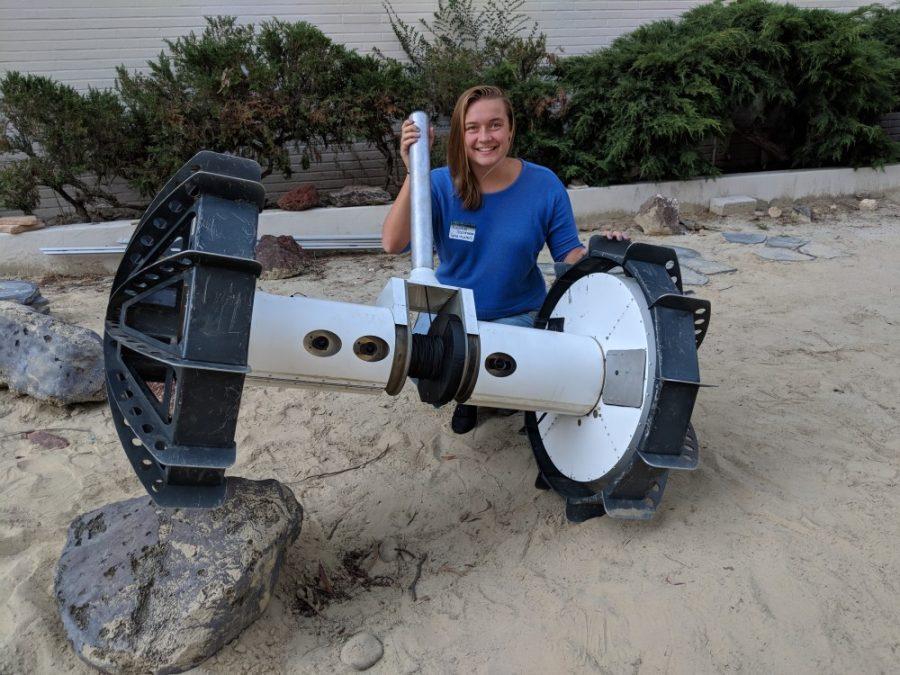On Saturday, July 20 at 8 p.m., in honor of the 50th anniversary of the Apollo 11’s moon landing, University of Arizona graduate student Amanda Stadermann spoke in the Warden Oasis Theater at the Arizona-Sonora Desert Museum about the moon’s continuing scientific significance.
Stadermann, a UA graduate student of geosciences and planetary sciences and lunar and planetary geologist at the Lunar and Planetary Laboratory, created an interactive presentation to illustrate both the importance and difficulty of NASA’s lunar missions.
According to Stadermann, a Desert Museum member, the Planetary Science Institute found her through her website and asked her if she would speak at the Desert Museum to honor the Apollo 11 moon landing, which occurred 50 years ago on July 20, 1969.
“I love the desert museum, personally … so I immediately said yes and was very grateful for the opportunity,” Stadermann said.
In her presentation, Stadermann encouraged the audience to design their own moon mission based on a few steps. Participants chose their preferred landing site, decided what to bring on the mission and drew their spacecraft, keeping a theoretical budget of $500 million.
Stadermann explained that the activity served as a simplified version of the process NASA goes through when designing a moon mission.
A variety of options for potential landing sites were given, and Stadermann explained the scientific significance of each, including a pit that could protect astronauts from harmful radiation and frozen water on the moon’s north and south poles. Both features could enable astronauts to stay on the moon longer.
Of all potential landing sites, Stadermann said she thought the best area to study would be the South Pole-Aitken basin, the largest impact basin on the moon.
“The interior of the moon is so important, and its composition is so important,” Stadermann said. “If you sent a sample return mission [to the South Pole-Aitken basin] that would be amazing … that would give us the best possible opportunity to study the mantle of the moon, which we don’t have.”
Stadermann said there is still so much more scientists can learn from the moon.
“For one, it’s a testing ground for a lot of other missions,” Stadermann said, “and … it has processes in its pure form, so if you want to study impact cratering or volcanism, then the moon is basically the best place for that because not much else happened on the moon and not much else will happen on the moon.”
Stadermann went on to note the moon’s importance to interdisciplinary studies, including how radio astronomy would be easier from the far side of the moon than it is from Earth.
Several audience members left the presentation more educated about NASA’s lunar missions and the moon in general.
Kate Robinson, an attendee of the presentation, said she was “surprised and happy that we’re still working to go back to the moon,” but that she was disappointed to learn how much NASA was limiting creative minds.
RELATED: Baffled about the black hole image? UA scientists behind it explain
Others gained more information after the formal presentation when they were given the chance to ask the lunar and planetary geologist questions.
Jeff Freeman, another audience member, said he had a better understanding of why viewers on Earth only see one side of the moon and “never get to see a different view.” Stadermann explained it takes exactly the same amount of time for the moon to rotate once as it does to complete a revolution about the Earth, meaning only one side will ever be visible.
Stadermann stayed after her presentation to speak one-on-one with attendees who wanted more information on the topic.
Annette Henderson, who spoke with Stadermann after the presentation, said that she liked how Stadermann “explained what a moonquake was – how it could occur,” since there are no plate tectonics on the moon. Stadermann explained to Henderson that moonquakes could be the result of impacts or expansion and contraction due to temperature changes.
As for the future of NASA missions, Stadermann is hopeful for a return to the moon and a change in NASA’s primary goals.
“I would like a continued focus on not just engineering goals, but science, and I think that is definitely going to happen,” Stadermann said.
She also said she thinks there will be NASA missions to the far reaches of the Solar System.
“That’s a very exciting place,” Stadermann said of the outer Solar System, “and there’s a lot of … possibility for habitability out there. So, there’s oceans underneath crusts of ice … that could be really important for … finding other life in the Solar System, which is NASA’s main goal.”
Stadermann said her ultimate career aspiration is to be a lunar astronaut and she said she believes her experience would make her a contender for the position.
“I think I’d be a great candidate since I’ve been studying the geology of the moon for six or seven years now,” Stadermann said.
Second to a trip to the moon, Stadermann said she would like to be a professor or a researcher at a university or NASA.
Follow Sam on Twitter









